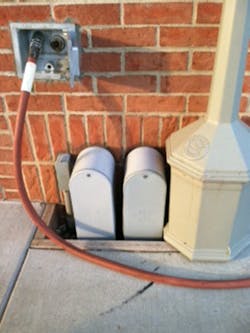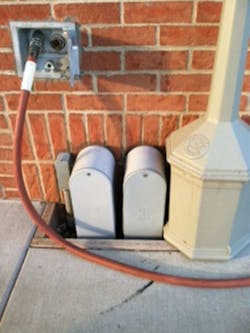How well do you know the Code? Think you can spot violations the original installer either ignored or couldn't identify? Here's your chance to moonlight as an electrical inspector and second-guess someone else's work from the safety of your living room or office. It's your turn to identify the violation.
Hint: Nice and tight
Find the Answer
Wayne Schneider, anestimator for Muth Electric, Inc., in Mitchell, S.D., sent us this photo, which shows an excellent violation example of the requirements in 314.29.
Boxes and conduit bodies, like those in the photo, must be installed in a manner so the wiring inside of them can be accessed without having to remove any building parts or without having to excavate the sidewalk, paved areas, or other finish material used to create the final grade.
As can be seen in this photo, the only way we could gain access to the wires inside those PVC conduit bodies is by breaking up the cement sidewalk in order to have enough room to remove the bottom cover screw. Although there is an exception in this section of the Code that permits listed boxes and handhole enclosures to be covered by loose soil, gravel, or other light aggregate where the box location is identified (and still accessible in the event it needs to be excavated), it doesn't apply to this installation.
Also, consideration should be given to the location of these PVC pipes since it may put them in a position to be subject to physical damage. Where PVC is exposed in areas subject to physical damage, heavier wall type Schedule 80 PVC conduit should be used instead of Schedule 40 PVC.
About the Author

Russ LeBlanc
Owner
Russ started in the electrical trade as an apprentice in 1985. He worked his way up to become a Journeyman Electrician and then eventually became a Master Electrician and Licensed Construction Supervisor. In 1999 Russ become an Electrical Instructor for The Peterson School of Engineering in Massachusetts where he developed his passion for teaching, and quickly became Department Head of Electrical Instruction. Russ has taught thousands of apprentices, electricians, engineers, inspectors, and other electrical professionals during his career as an instructor. He continues to provide electrical professionals with Electrical Code seminars, Arc-Flash Awareness training seminars and educational material through his LeBlanc Consulting Services in North Reading, MA whose specialty is educating electricians. He has been an active member of the NFPA Electrical Section and has authored hundreds of National Electrical Code proposals and comments which have become Code rules to improve the safety for the electrical industry. Russ is also an IAEI certified Electrical Inspector.
Please visit www.russleblanc.net for more information.

